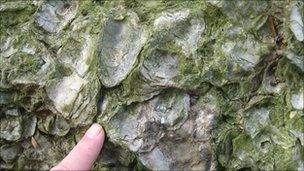UEA scientist solves Oxburgh Hall boulder mysteries
- Published

Fossilised oyster shells can be seen in the boulder at Oxburgh Hall
The mysteries of an unusual boulder at a Norfolk stately home have been solved, thanks to geological detective work by the University of East Anglia.
The boulder at Oxburgh Hall, near Swaffham, is composed of hundreds of fossilised oyster shells and is known locally as the Roman Oyster Stone.
Professor Julian Andrews from UEA has been investigating the rock.
He found it dated back 165 million years and had been transported from 60 miles away near Sleaford, Lincolnshire.
Professor Andrews from the university's school of environmental sciences was called in by the National Trust, which owns the 15th Century moated manor house.
Oyster beds
He dated the boulder in the hall's gardens by looking at the species of oyster fossils within it.
He said it dated from the Middle Jurassic age and could more accurately be described as a "roamin' stone".
The closest boulders which are similar in structure can be found exposed in a narrow band in the East Midlands, between Northampton and Lincoln.
There are known oyster-bearing beds in the Grantham and Sleaford area.
Dredged from river
"It is highly likely the boulder originated from hereabouts and this tells geologists it was moved by ice flowing broadly south-east, crossing modern day Fenland in the Spalding-Wisbech area," he said.
"The local bedrock geology in this part of West Norfolk is cretaceous chalk, about 90 million years old - a much younger geological unit than the boulder."
He said glaciers often picked up fragments of the bedrock over which they flowed.
"As the ice flows, the boulders are transported and then dumped when the ice melts," he said.
"A boulder which is moved from its place of origin and then dumped, perhaps miles away, often on quite unrelated bedrock, is known as an 'erratic'."
The Oxburgh Hall stone, which is about 1m (3ft) long and 50cm (1.5ft) across, was dredged from the nearby River Wissey about 50 years ago.
Teresa Squires, National Trust property manager for Oxburgh Hall, said: "It is now officially the oldest artefact at Oxburgh and we hope it will be of great interest to our visitors."
- Published3 August 2011